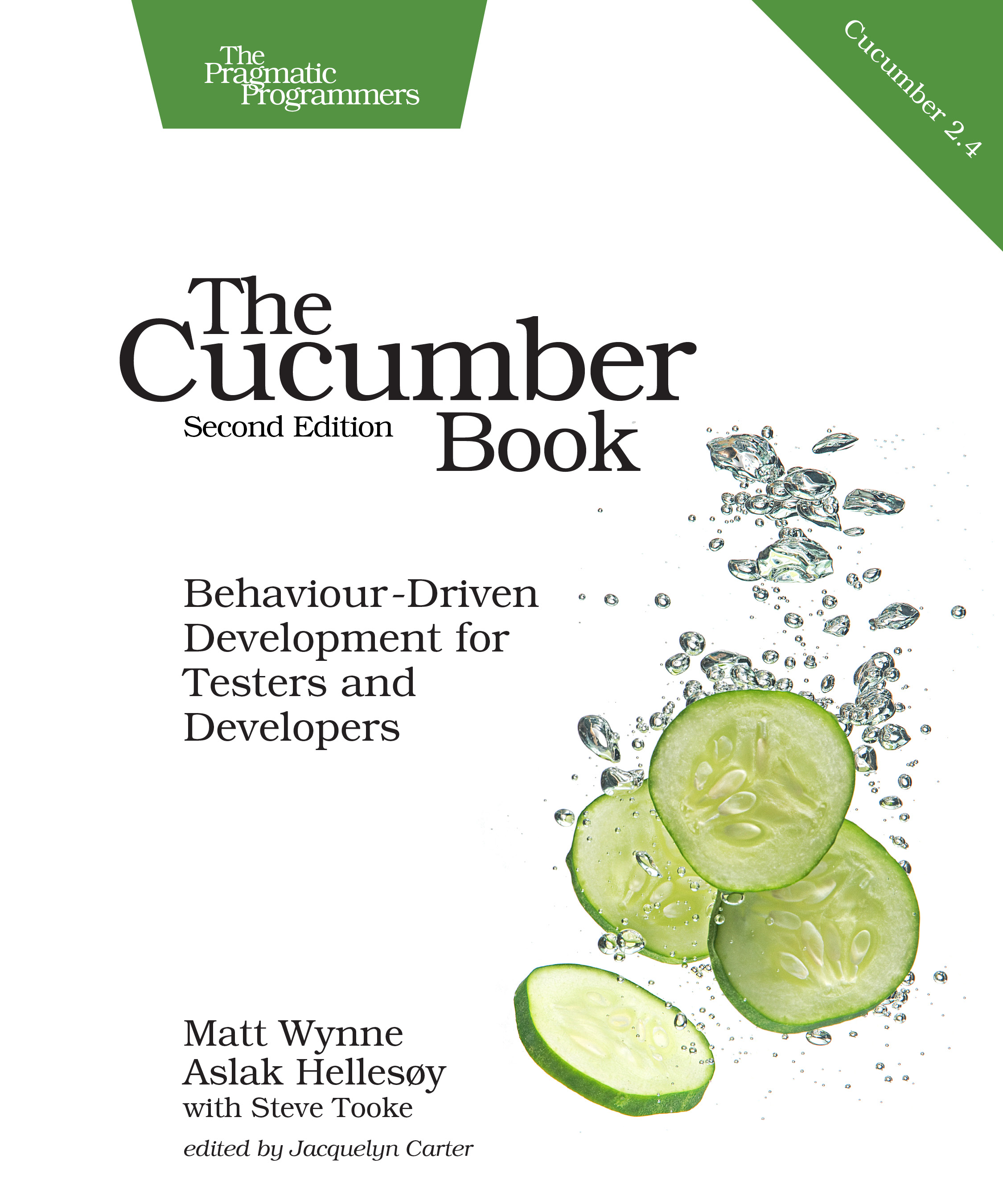The Cucumber Book, Second Edition
Behaviour-Driven Development for Testers and Developers
by: Matt Wynne and Aslak Hellesøy, with Steve Tooke
| Published | 2017-02-08 |
|---|---|
| Internal code | hwcuc2 |
| Print status | In Print |
| Pages | 334 |
| User level | Beginner |
| Keywords | requirements, agile, ruby, customer, behavior, DSL, gherkin |
| Related titles | Rails 4 Test Prescriptions |
| ISBN | 9781680502381 |
| Other ISBN |
Channel epub: 9781680504965 Channel PDF: 9781680504972 Kindle: 9781680502480 Safari: 9781680502497 Kindle: 9781680502480 |
| BISACs | COM051240 COMPUTERS / Software Development & Engineering / Systems Analysis & DesignCOM051390 COMPUTERS / Programming / Open SourceCOM051390 COMPUTERS / Programming / Open Source |
Highlight
Your customers want rock-solid, bug-free software that does exactly what they expect it to do. Yet they can’t always articulate their ideas clearly enough for you to turn them into code. You need Cucumber: a testing, communication, and requirements tool—all rolled into one. All the code in this book is updated for Cucumber 2.4, Rails 5, and RSpec 3.5.
Description
Express your customers’ wild ideas as a set of clear, executable specifications that everyone on the team can read. Feed those examples into Cucumber and let it guide your development. Build just the right code to keep your customers happy. You can use Cucumber to test almost any system or any platform.
Get started by using the core features of Cucumber and working with Cucumber’s Gherkin DSL to describe—in plain language—the behavior your customers want from the system. Then write Ruby code that interprets those plain-language specifications and checks them against your application. Next, consolidate the knowledge you’ve gained with a worked example, where you’ll learn more advanced Cucumber techniques, test asynchronous systems, and test systems that use a database. Recipes highlight some of the most difficult and commonly seen situations the authors have helped teams solve. With these patterns and techniques, test Ajax-heavy web applications with Capybara and Selenium, REST web services, Ruby on Rails applications, command-line applications, legacy applications, and more.
Written by the creator of Cucumber and the co-founders of Cucumber Ltd., this authoritative guide will give you and your team all the knowledge you need to start using Cucumber with confidence.
Contents and Extracts
- Cucumber Fundamentals
- Why Cucumber? <b>excerpt</b>
- Automated Acceptance Tests
- Behaviour-Driven Development
- Living Documentation
- How Cucumber Works
- What We Just Learned
- First Taste
- Understanding Our Goal
- Creating a Feature
- Creating Step Definitions
- Implementing Our First Step Definition
- Running Our Program
- Changing Formatters
- Adding an Assertion
- Making It Pass
- What We Just Learned
- Gherkin Basics <b>excerpt</b>
- What’s Gherkin For?
- Format and Syntax
- Feature
- Scenario
- Comments
- Spoken Languages
- What We Just Learned
- Step Definitions: From the Outside
- Steps and Step Definitions
- Capturing Arguments
- Multiple Captures
- Flexibility
- Returning Results
- What We Just Learned
- Expressive Scenarios
- Background
- Data Tables
- Scenario Outline
- Nesting Steps
- Doc Strings
- Staying Organized with Tags and Subfolders
- What We Just Learned
- When Cucumbers Go Bad
- Feeling the Pain
- Working Together
- Caring for Your Tests
- Stop the Line and Defect Prevention
- What We Just Learned
- Why Cucumber? <b>excerpt</b>
- A Worked Example
- Step Definitions: On the Inside <b>excerpt</b>
- Sketching Out the Domain Model
- Removing Duplication with Transforms
- Adding Custom Helper Methods to the World
- Organizing the Code
- What We Just Learned
- Support Code
- Fixing the Bug
- Bootstrapping the User Interface
- Making the Switch
- Using Hooks
- Building the User Interface
- What We Just Learned
- Dealing with Message Queues and Asynchronous Components
- Our New Asynchronous Architecture
- How to Synchronize
- Implementing the New Architecture
- Fixing the Flickering Scenario
- What We Just Learned
- Databases
- Introducing ActiveRecord
- Refactoring to Use a Database
- Reading and Writing to the Database
- Cleaning the Database with Transactions
- Cleaning the Database with Truncation
- What We Just Learned
- Step Definitions: On the Inside <b>excerpt</b>
- Cucumber Applied
- The Cucumber Command-Line Interface
- Cucumber’s Command-Line Options
- Running a Subset of Scenarios
- Changing Cucumber’s Output
- Specifying the Location of Step Definitions
- Managing Your Work in Progress (WIP)
- Using Profiles
- Running Cucumber from Rake
- Running Cucumber in Continuous Integration
- What We Just Learned
- Testing a REST Web Service
- In-Process Testing of Rack-Based REST APIs
- Out-of-Process Testing of Any REST API
- What We Just Learned
- Adding Tests to a Legacy Application <b>excerpt</b>
- Characterization Tests
- Squashing Bugs
- Adding New Behavior
- Code Coverage
- What We Just Learned
- Bootstrapping Rails
- Running the Generators
- Creating a User
- Posting a Message
- Associating a Message with a User
- Creating a Controller by Hand
- Implementing the View
- What We Just Learned
- Using Capybara to Test Ajax Web Applications
- Implementing a Simple Search Without Ajax
- Searching with Ajax
- The Capybara API
- Taking Screenshots
- What We Just Learned
- Testing Command-Line Applications with Aruba
- Simple Interfaces
- Our First Aruba Feature
- Working with Files and Executables
- Interacting with User Input
- Using Aruba’s Ruby DSL
- What We Just Learned
- The Cucumber Command-Line Interface
